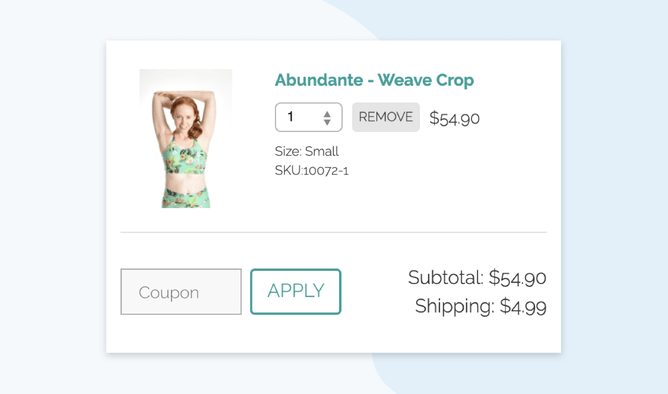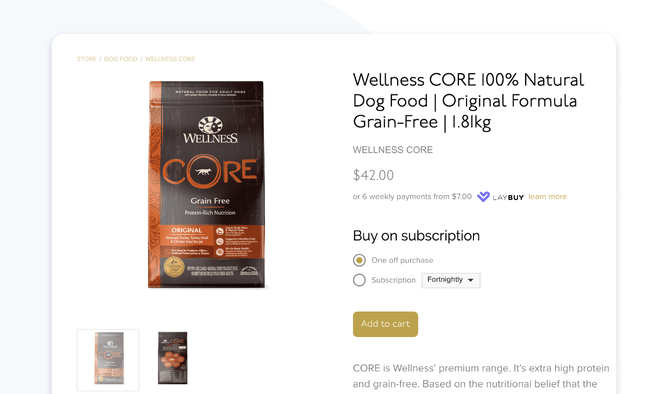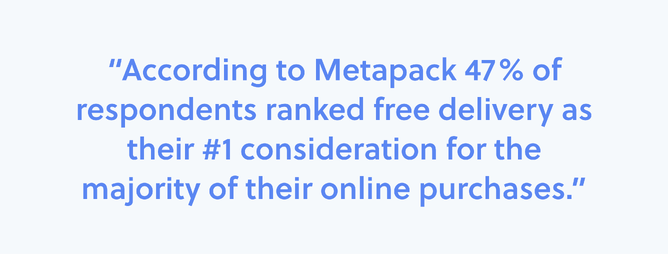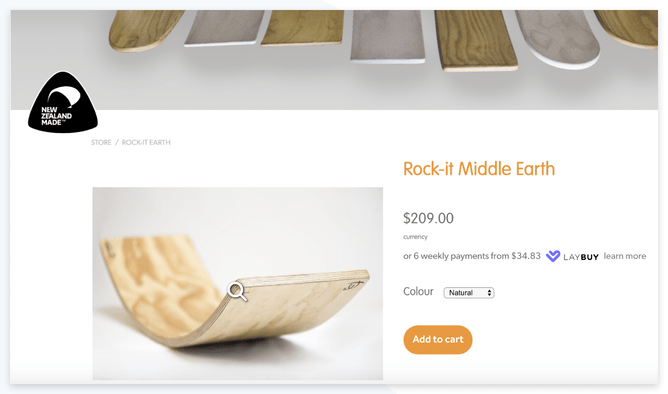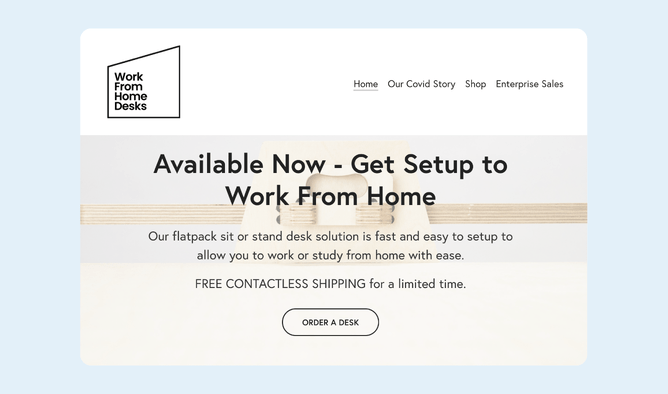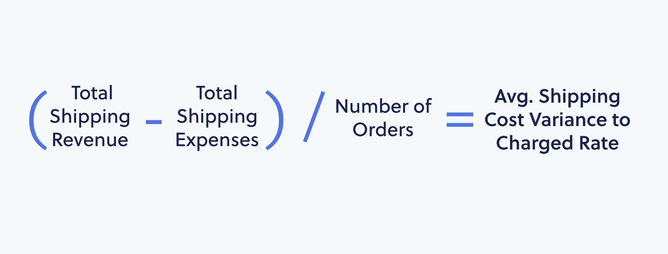Ecommerce shipping rates are one of the most confusing aspects of ecommerce for new merchants. Different courier providers structure their pricing in different ways. Bags, boxes, stickers, weight, size, free shipping, flat rate shipping, high dollar items, low-value items, extra-large or heavy items?
So how should I set up my shipping?
This post showcases the most popular ecommerce shipping techniques used by some of the largest ecommerce retailers—and why they can still work for smaller ones.
Cart abandonment averages 69% and according to Baymard research institute, 50% of those carts abandon because extra costs like shipping or taxes are too high—so if you could capture even a small percentage of those could-be customers' carts with a better shipping strategy, the revenue potential is significant.
Why are flat-rate models the most common?
Whether offering a flat rate nationwide or a flat rate by area or region, flat rate shipping models are the most common setup online shoppers will experience—but what does this mean?
In a nutshell, some products may cost more or less than other products to get delivered to your customers. For many ecommerce stores, the variance in shipping costs is likely to only be a few bucks. This makes it easy to settle on an average price for shipping, so you can offer a flat rate for the majority or all of your products. The certainty of flat rate shipping is more beneficial to the customer than saving a small amount of precise weight-calculated shipping for each and every product.
If you have some products that are significantly larger or heavier than your average product, this can be easily taken care of with a bulky rate just for those products and we’ll talk about that later in the post.
Legendary user experience researcher Jacob Nielsen is credited with Jacob’s Law of User Experience:
“Users spend most of their time on other sites. This means that users prefer your site to work the same way as all the other sites they already know.”
If Jacobs Law is true, potential customers will expect simple shipping rates like they see most commonly elsewhere—rather than complex rates that vary with every product and frustrate buyers looking to buy a cart full of items.
But why is flat rate shipping the most common option?
- It’s more convenient for the buyer. They know that whatever they buy, there will be no shipping rate surprises at the checkout—especially with free shipping, which is hugely popular with online retailers.
- It’s less admin time for the merchant. You don’t have to enter weights or size measurements for every product. With a large inventory that’s constantly being added to, the human cost of that is huge.
Many online stores employ digital ad campaigns—the cost to acquire a customer would usually be much higher than any small incremental margin lost by offering attractive but simplified shipping rates.
How do I set up flat rate shipping?
Work out your average shipping cost across all of your sales (or sales for each shipping region if your courier provider has different rates for different areas) and set the flat rate higher than the average to cover your time and packaging costs—this way you aren’t at risk of shipping costing more than you’re charging.
For activewear online retailer Zeenya, all of their packages are a similar size and weight, so it’s simple for them to offer NZ$4.99 flat rate shipping nationwide in New Zealand, with higher rates to ship internationally.
But what if I’m just starting out and don’t yet know my average shipping costs for an area?
Get some prices from courier providers for packages in your average size ranges and start with this. Then after you have enough sales to work out a reliable average, adjust your shipping rate up or down. We would recommend getting a courier provider you don’t have to pre-pay with when you’re starting out as you can push your delivery costs until after you get the sale and don’t have to stockpile prepaid courier bags or stickers. Go Sweet Spot is a shipping add-on for Rocketspark that streamlines the shipping process and offers payment on the invoice at the end of the month.
The reality is that for most ecommerce stores, the raw cost of shipping will only vary by a few dollars from item to item—a difference that most buyers won’t blink an eyelid at. For small/regular sized items, flat rate shipping is usually under $10 for domestic deliveries. With Rocketspark you can set up shipping rates by country so you can account for the higher cost of shipping internationally.
What if my average shipping rate is high and off-putting to all customers?
If your average shipping rate is high and you have a high variance between your lowest and highest cost products to ship, you could consider setting up a range of shipping rates. This is effectively setting up weight or size based shipping at as granular a breakdown as you like.
For Assault Boardriding Centre they’ve set up 15 different rates. They have a standard rate, a paddle rate and a range of rates for their different sizes of paddleboards. Shipping a 10-foot paddleboard is going to cost more than a small accessory so in this instance flat rate shipping storewide wouldn’t be suitable.
You could set up a small rate, medium rate and a large rate—or light rate, regular rate, heavy ratedepending on how your courier provider charges. This is effectively 3 averaged rates. So for the small rate, you would price it as the average shipping cost for products that fit in the small size range.
Or you could even go more granular and effectively set up weight-based shipping by having rate ranges like 0-250g, 250g-500g, 500g-750g, 750g-1000g, and on it goes—but don’t forget this carries the admin cost of having to measure the weight of each new product and enter that data. With regular and bulky, it’s likely just by glancing at the product you’ll be able to decide on the correct rate.
Multi-region flat rate shipping
Flaxman Wines in South Australia have a single shipping rate with a different price for each state in Australia and a variance of $21 between the lowest and highest region shipping price.
Ivy Florist in Cambridge, New Zealand has one shipping rate, indicating that all of their products are effectively at a flat rate but they have 8 different delivery areas within that rate, each with a slightly different price between $10 and $20.
Another example is Pure and Wholesome who have some bulky products such as 10kg bags of dog food and use a bulky rate for those items.
My brother and fellow Rocketspark co-founder Grant used to be a part-owner of Pure and Wholesome and when they switched to Go Sweet Spot, that automated their order tracking and “Where is my order?” inquiries stopped. According to Grant, this really saved on admin time.
“We set up different shipping types in Go Sweet Spot for the various potential order sizes. We set a free delivery spend level and also those under the free delivery spend level paid a flat rate for North Island and a flat rate for South Island. For local deliveries, we saved a little on the courier cost and for further afield deliveries we lost a little but we had some allowance in the product margin for delivery and the priority was to keep it simple and maximise sales.”
What about free shipping?
Shipping aggregation tool Shippit shares some interesting stats regarding free shipping over on their blog.
As long as you’re not selling low-price products, you could consider factoring average shipping costs into the cost of the product and then advertise free shipping to your customers. While they are still effectively paying something towards the cost of shipping through the margins you put on your products, for the buyer there are no surprises and you can promote free shipping on your home page—so they know as early as possible what the charges will be (or won’t be in this case).
Shippit cites research that shows other significant benefits to free shipping:
“Studies have shown that a customer is more likely to purchase a higher-priced product with free shipping than if the price point was lower, with shipping was added separately...
...In fact, offering free shipping could actually save you money. Think about it; free shipping could increase traffic to your site, lower your cost per acquisition and increase the quality of your customer; creating higher customer lifetime value…
...Or to put it another way, you will see 15-30% improvement in net profit.”
Rocketspark ecommerce client Rockitboards offers free shipping nationwide, then charges shipping by country for international orders.
With Rocketspark it’s also possible to offer free shipping if buyers spend over a certain amount. This can be an effective way to incentivise customers to buy more. Effectively banking on the increased revenue taken on the margin of the additional spend outweighing the shipping cost.
For healthy snack food brand Nothing Naughty, they charge $5 flat-rate nationwide but then give free shipping on orders over $19. Craft beer and cider brewers Good George are selling packs of squealers (1-litre glass bottles) and 6 packs that are reasonably heavy but they’re still offering $5 flat rate shipping. Don’t sweat the small stuff and win on the sales front.
Work From Home Desks is a brand new ecommerce store that opened during New Zealand’s level 4 COVID-19 lockdown. They sell high quality flat-pack birch-ply desks that can be assembled in minutes without any tools and adjusted to multiple sit or stand heights. The desks range from $379 - $579 and are 21-24kg’s when boxed (1200mm x 880mm). This is significantly heavier and larger than an average ecommerce package and more expensive to ship—and yet they’re still able to offer free shipping. Why did co-founder Joe Bradford decide on limited-time free shipping? Joe said that as a new brand in the market, offering limited-time free shipping helps remove a potential barrier for buyers on the fence. “We advertise the offer at the top of our homepage so concerns about shipping costs are eliminated right up front,” says Joe.
For Work From Home Desks, there can be a $35 variance in their shipping rates depending on the location (this is a much larger variance than most ecommerce businesses because of the size and weight of their products) but they are effectively smoothing over this variance to appeal to all customers. Work From Home Desks wanted to hit the market as a nationwide brand from the get-go, so removed the distraction of regionalised shipping rates for the buyer.
What if some of my inventory costs a lot more to ship (bulky rates)
If a small percentage of your products are much larger or heavier than your average product, it’s likely they’ll cost much more to send to customers. In this instance, a bulky rate is a popular approach. This was something my fellow Rocketspark co-founder Richard King saw work well at his previous employer Torpedo7.com. Small items would be at the regular flat rate and large items like bikes or large canvas tents might be at a bulky rate.
By offering only two rates, it is a simple binary decision for warehousing and inventory staff to assign a product to one of two categories. Torpedo7 later joined The Warehouse group and thewarehouse.co.nz employs the same concept. If you buy a t-shirt, you get the regular shipping rate of $5. If you buy a barbecue you get the oversized delivery rate of $60.
This is how homeware and fashion store Leven have set up their shipping, with 2 different shipping rates for different types of products—one of them a large/oversized rate at $20 nationwide and the other a standard (everything else) rate of $5 throughout New Zealand.
Sinco Customs is an example of a store that sells large heavy mechanical parts. They have 18 different shipping rates for different product groupings and also employ the additional item rate so that if someone buys two of a heavy item, there are additional charges reflected.
What about local delivery rates?
If your local area delivery costs are significantly lower than sending further afield and you want to get sales traction with your local customers, offering a lower-cost local area shipping rate can be a good idea—so that you’re passing on those savings to local buyers.
But why are some merchants hung up on weight-based shipping down to the gram?
There can be a few key reasons exact weight-based shipping can seem attractive to merchants:
1. It’s the only way you’ve known. If you had weight-based shipping on your existing website and feel like it’s working well, it would make sense to want to continue that (especially if your courier company charges you based on the weight of the package). An escalating shipping cost based on cart size is going to be a real buzzkill for people increasing their cart sizes with more items. Encouraging larger cart sizes can have a really positive impact on your sales. The larger the cart, the more margin you’ve captured overall, so even if you lose out slightly on shipping on large orders — happy days! Just make sure the margin is high enough to cancel that out. This is exactly why “free shipping” over $50 spend offers exist. Not penalising larger cart volumes with increasing shipping rates is another way to entice larger cart sizes.
2. Not understanding the lucrative benefits of reducing cart abandonment through the use of flat rate or free shipping. Also if you set up cart abandonment emails, reminding people of your free shipping offer can be a good way to entice them back to buy.
3. If your item is particularly low priced and the tracked courier costs are similar or higher than the price of the product. If all of your store items are small like this, this will be reflected in your average shipping cost and a lower than normal flat rate shipping could apply. If the item is low-value (less than $5) you could consider untracked postage to bring the postage cost down. The benefits of tracked postage are more appealing to customers as the price of their order increases.
4. What if the item is high value but small in size? In this instance, people’s expectation around shipping value is related to the order value, not the shipping costs. If they can pay $10 for an item that’s small, fragile and worth $50 like a glass bottle of essential oil (even though it’s small, light and with bubble wrap is inexpensive to ship) to make sure the item arrives safely, they’ll be willing to pay. Although $10 is definitely on the higher side for flat rate shipping of a small item, a beneficial outcome here could be that it incentivises buyers to increase their basket size to make the order more worthwhile.
Start with simple, then check the numbers
When you’re starting out in ecommerce, keep it simple on shipping rates. Hey, even try offering free shipping initially to start getting initial sales and building word of mouth. Keep an eye on what your courier provider is charging for each package. You should have a pretty good gut feeling for how often you’re paying more for shipping than your customers are paying you. Then after a month or two of sales, do a simple profit and loss analysis on your shipping.
If the number is positive, you’re breaking even on your shipping. If the number is negative, you’re losing on your shipping. You may decide that’s ok but at least you know and can decide whether low or free shipping is more important for sales than getting an extra dollar or two on each order.
It’s no surprise that many of the examples above have settled on $5 flat rate shipping. This seems to be the most common rate in New Zealand and is a good round number that’s high enough to cover the majority of the courier costs but not so high as to put off potential buyers.
